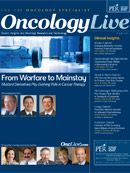Publication
Article
Oncology Live®
5 Questions for Martin Steffen, MD, PhD
Author(s):
Martin Steffen, MD, PhD, developed phosphorylation signatures that discriminate between lung tumors and normal lung, and is developing signatures for the prediction of therapy response.

Martin Steffen, MD, PhD
Martin Steffen, MD, PhD, is a principal investigator at Boston University School of Medicine in the Department of Pathology and Laboratory Medicine, and the Department of Biomedical Engineering. Partnering with Simon Kasif, PhD, also of BU, he developed phosphorylation signatures that discriminate between lung tumors and normal lung, and is developing signatures for the prediction of therapy response.
1
What is the role of protein phosphorylation in a normal cell?
The phosphorylation of a protein is a covalent chemical modification that can regulate the activity of the protein. In basic terms, it can be thought of as an “on/off” switch for the particular protein that is phosphorylated.
2
How is dysregulated protein phosphorylation implicated in cancer?
In cancers, it is frequently found that proteins are aberrantly phosphorylated, often due to a mutation somewhere in the cancer genome. This can have the effect of turning a protein “on” when in normal tissue the protein should be in an “off” state. This is especially true of signaling proteins that drive cellular proliferation.
3
How has our understanding of protein phosphorylation been exploited in cancer research and drug development?
One of the most exciting new classes of drugs is the tyrosine kinase inhibitors (TKIs). These drugs target protein phosphorylation events, blocking them in an attempt to prevent the tumor from proliferating. The results can be dramatic; one of the first TKIs, Gleevec (imatinib), showed great initial efficacy for gastrointestinal stromal tumors.
4
How can we use protein phosphorylation status as a biomarker or prognostic indicator?
We believe that the patterns of phosphorylation in a cell will reveal the pathways that are activated in those tumors, and therefore suggest which drugs might be efficacious for those tumors. Many others are attempting to do the same by looking at DNA mutations in the cancers. Both avenues are very promising.
5
What are the future challenges to our understanding of protein phosphorylation?
One goal would be a comprehensive catalog of the phosphorylation status of all proteins in tumors. A second goal would be knowledge of the tumor’s “weak points,” basically knowing which phosphorylated proteins could be targeted to maximally destroy the tumor cells, while preserving normal tissue.








